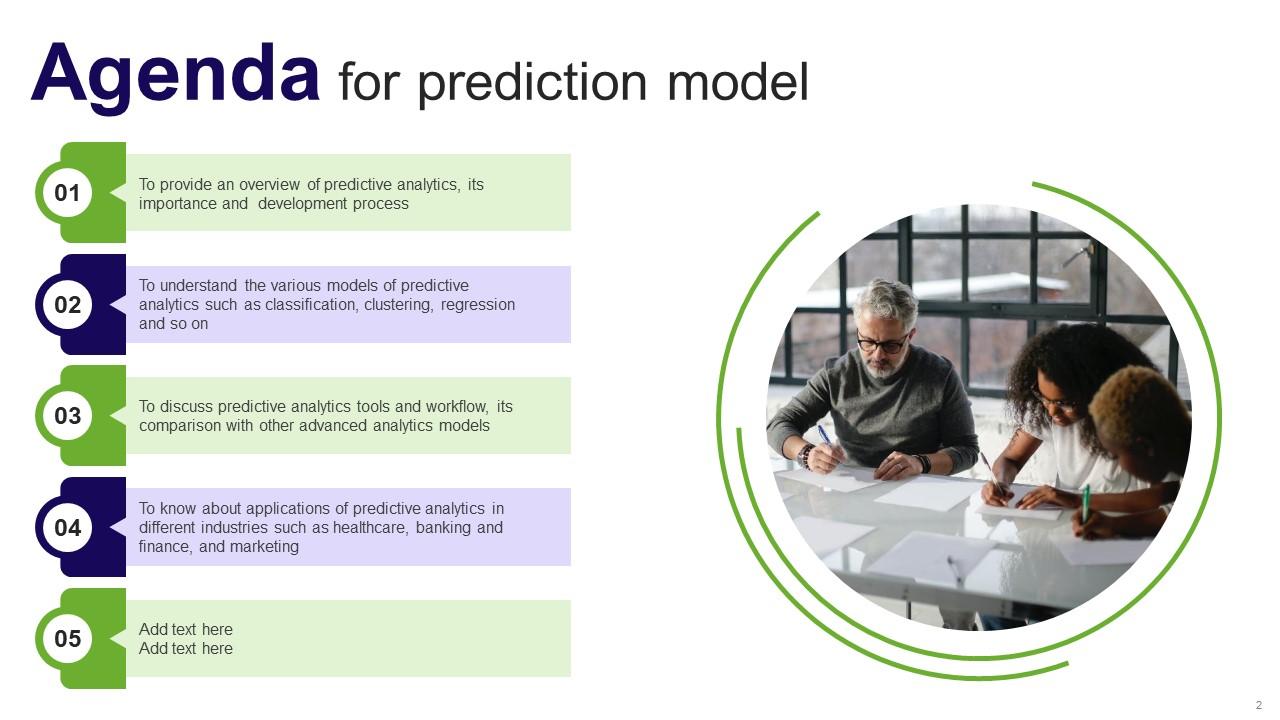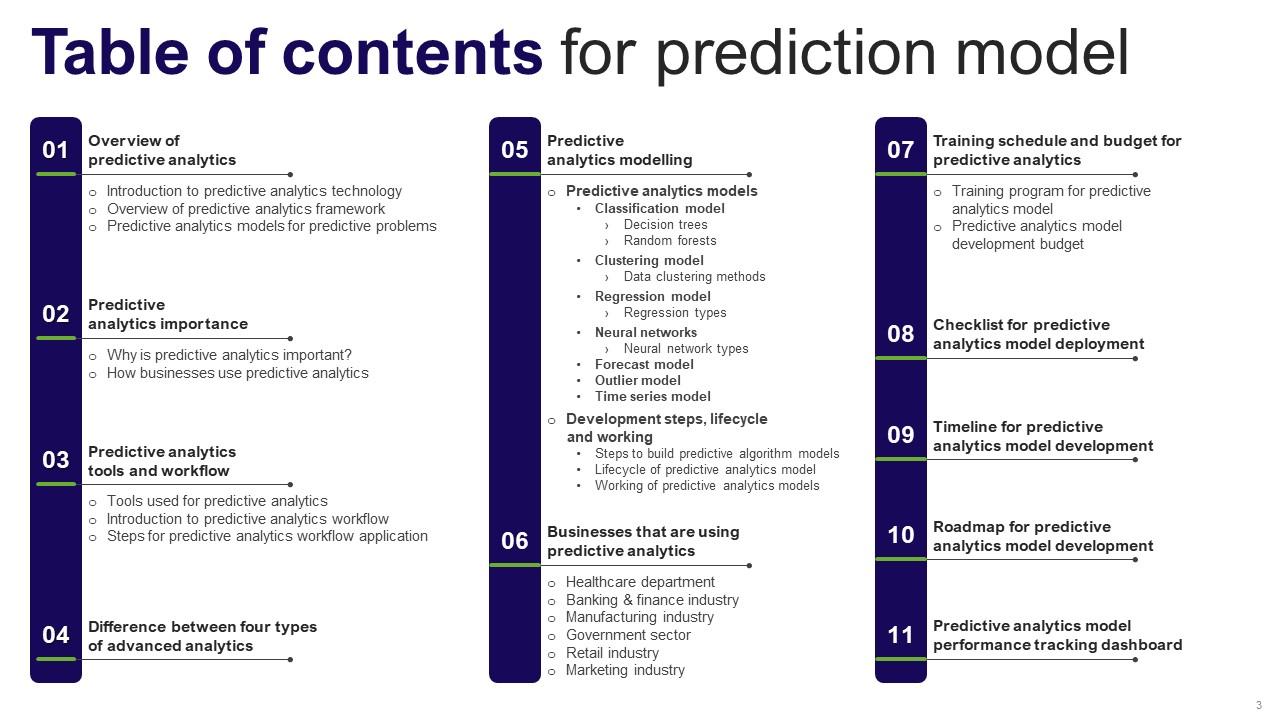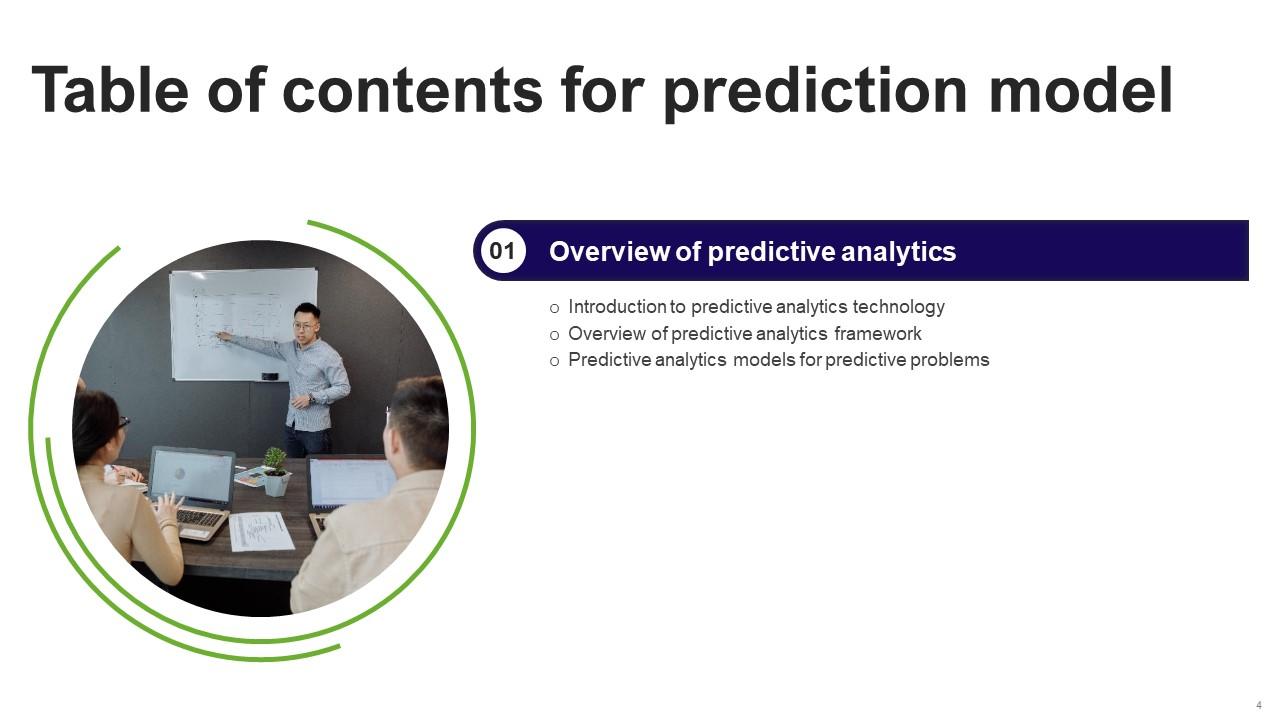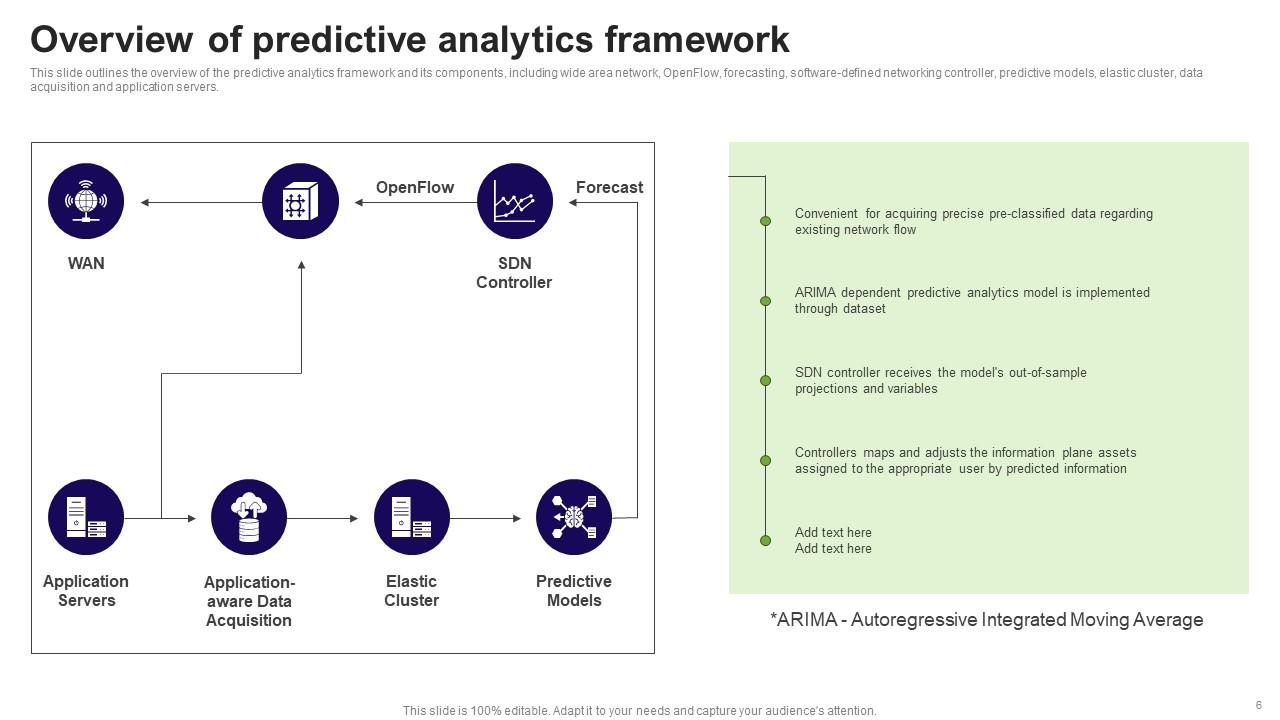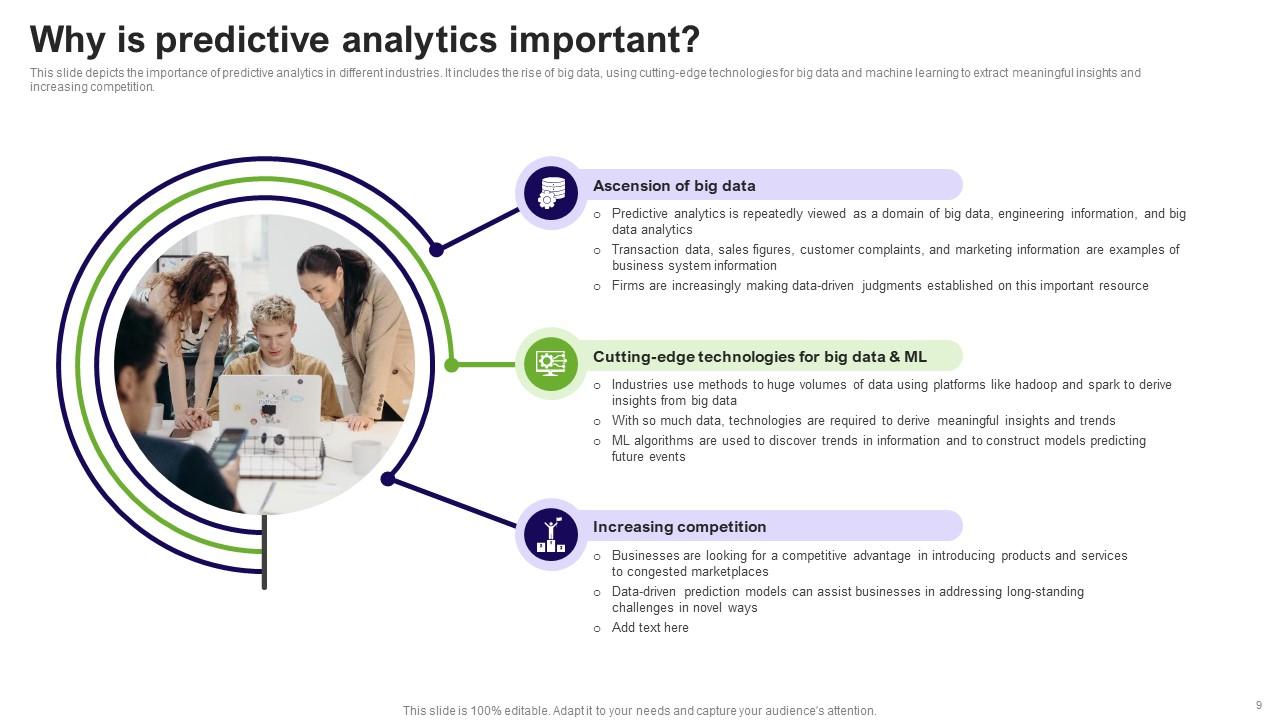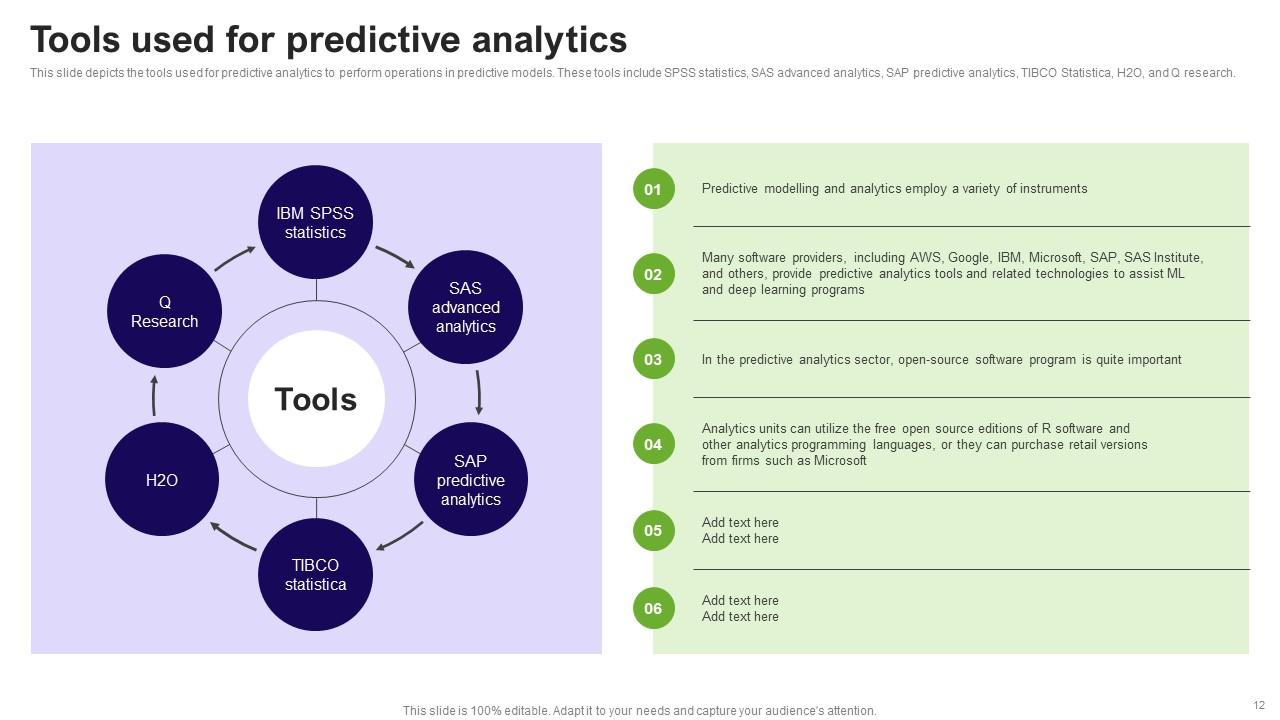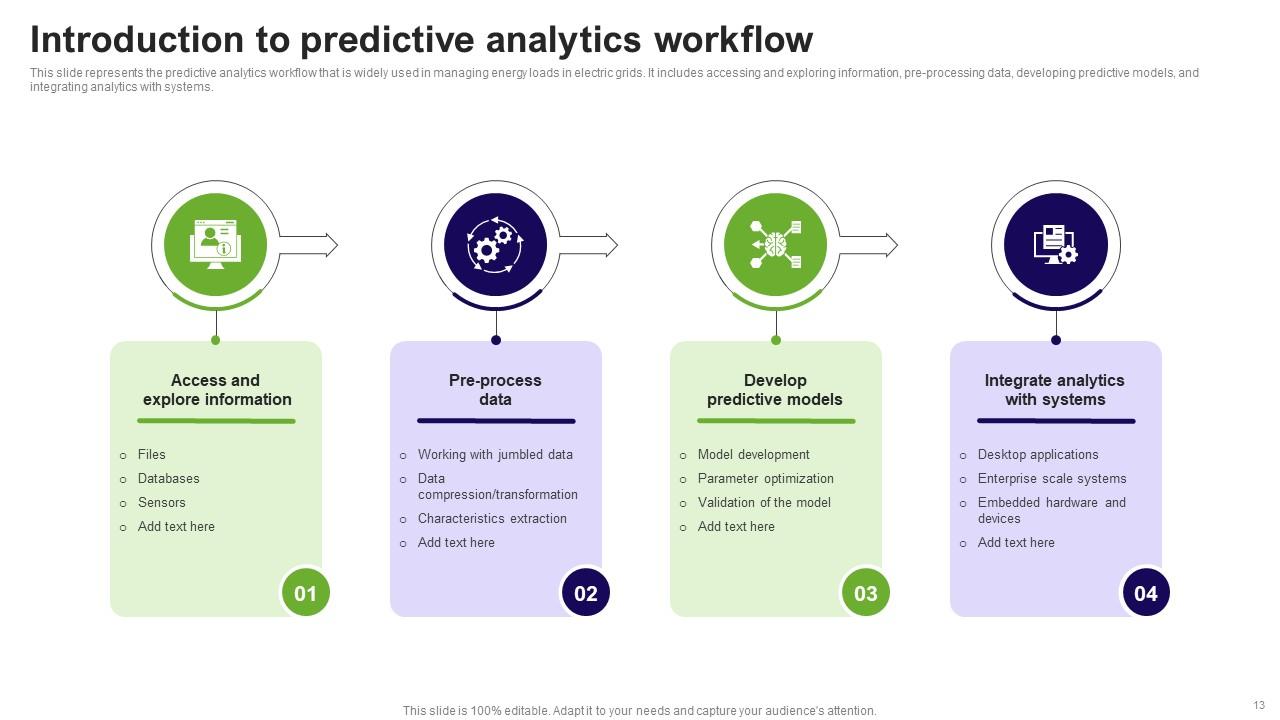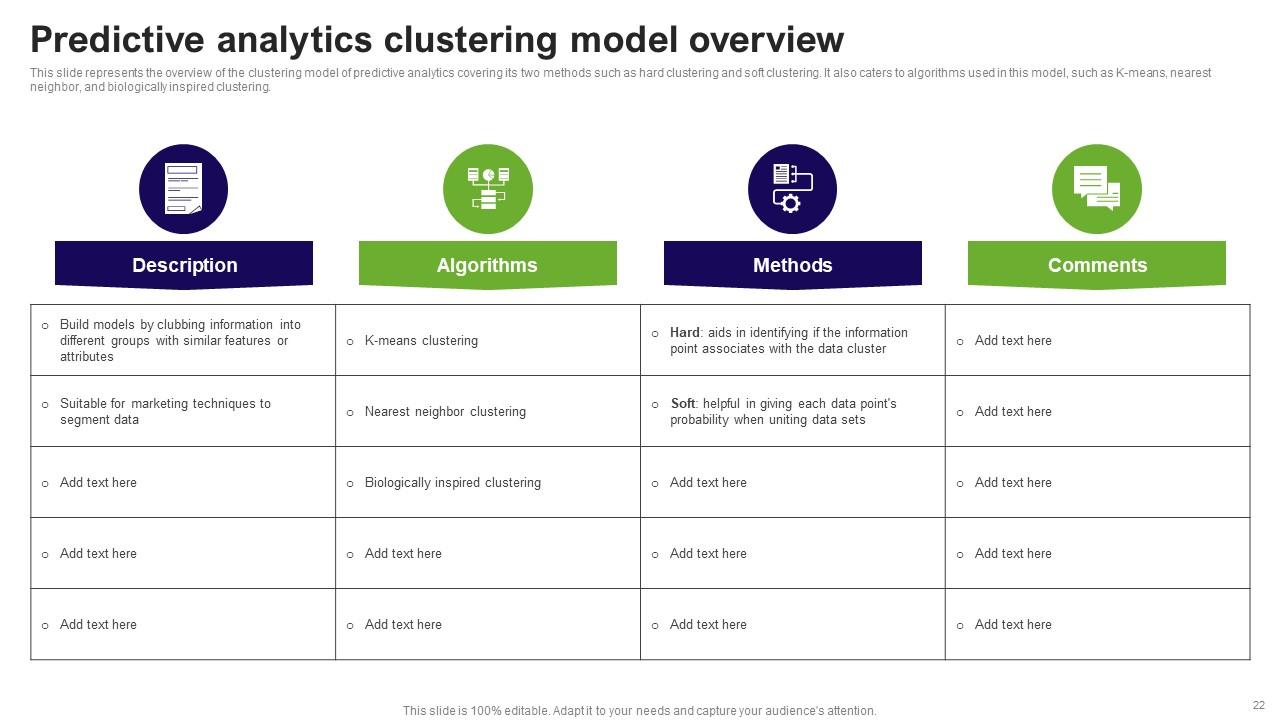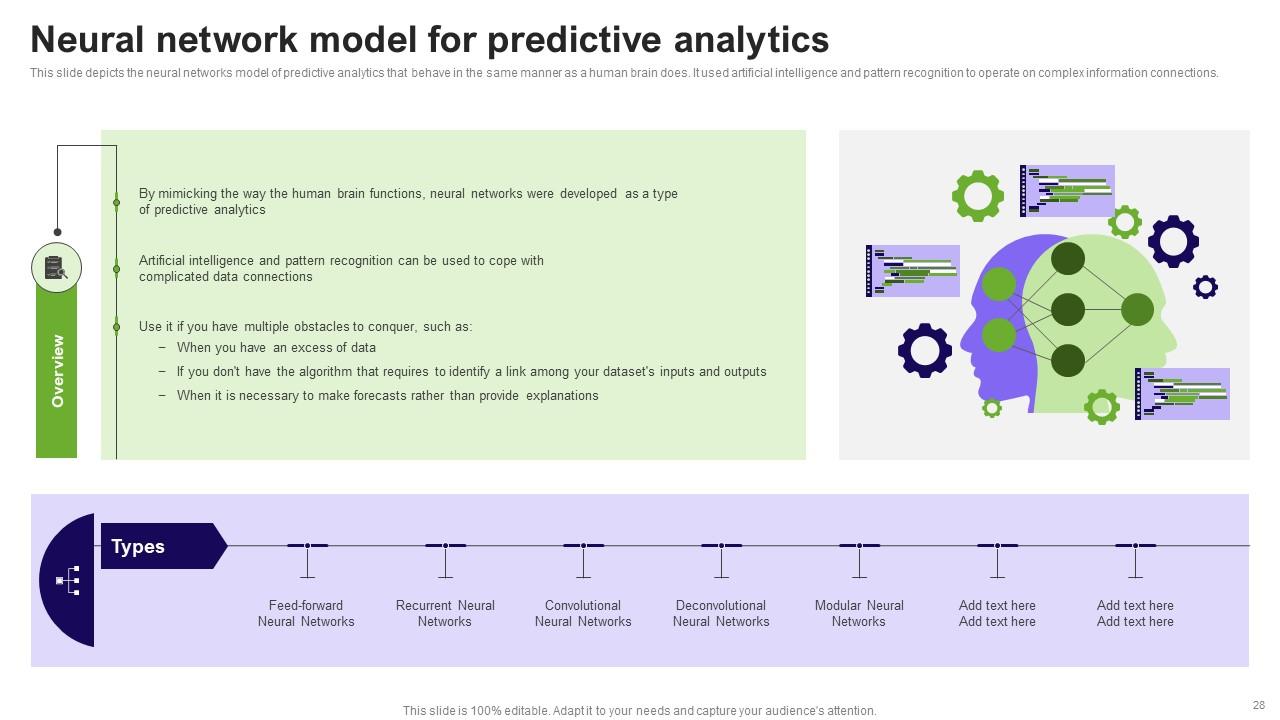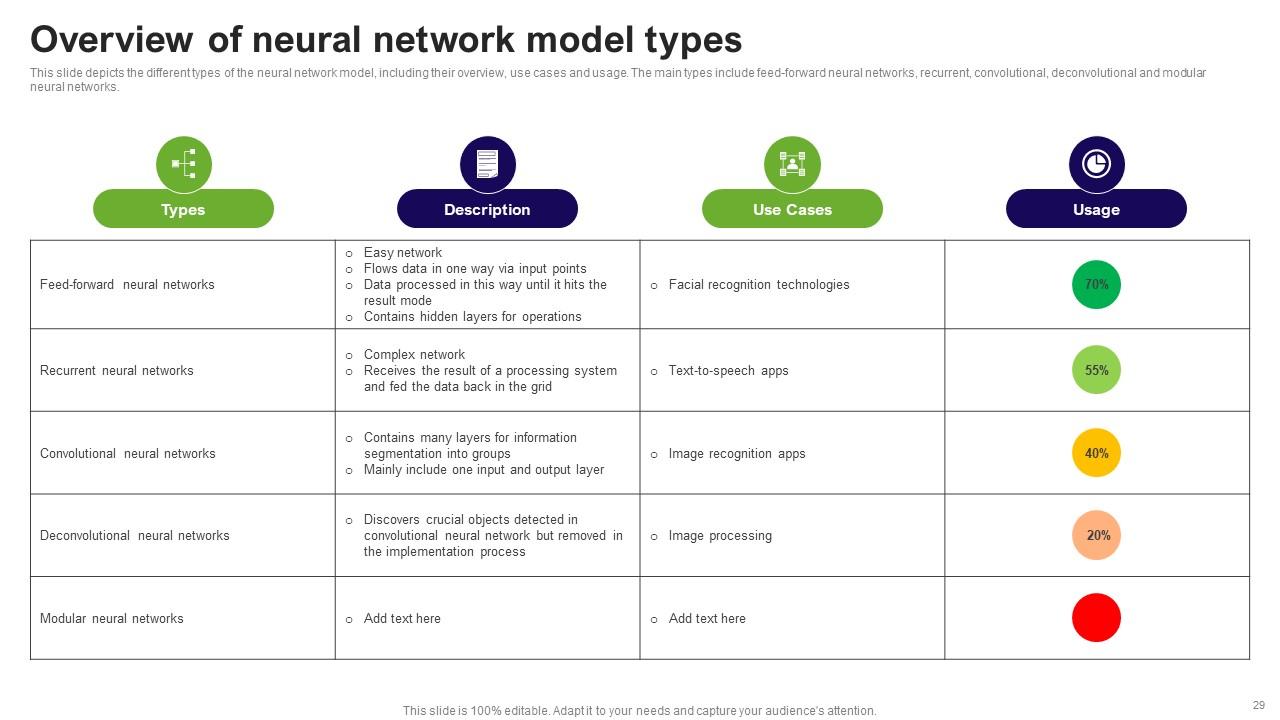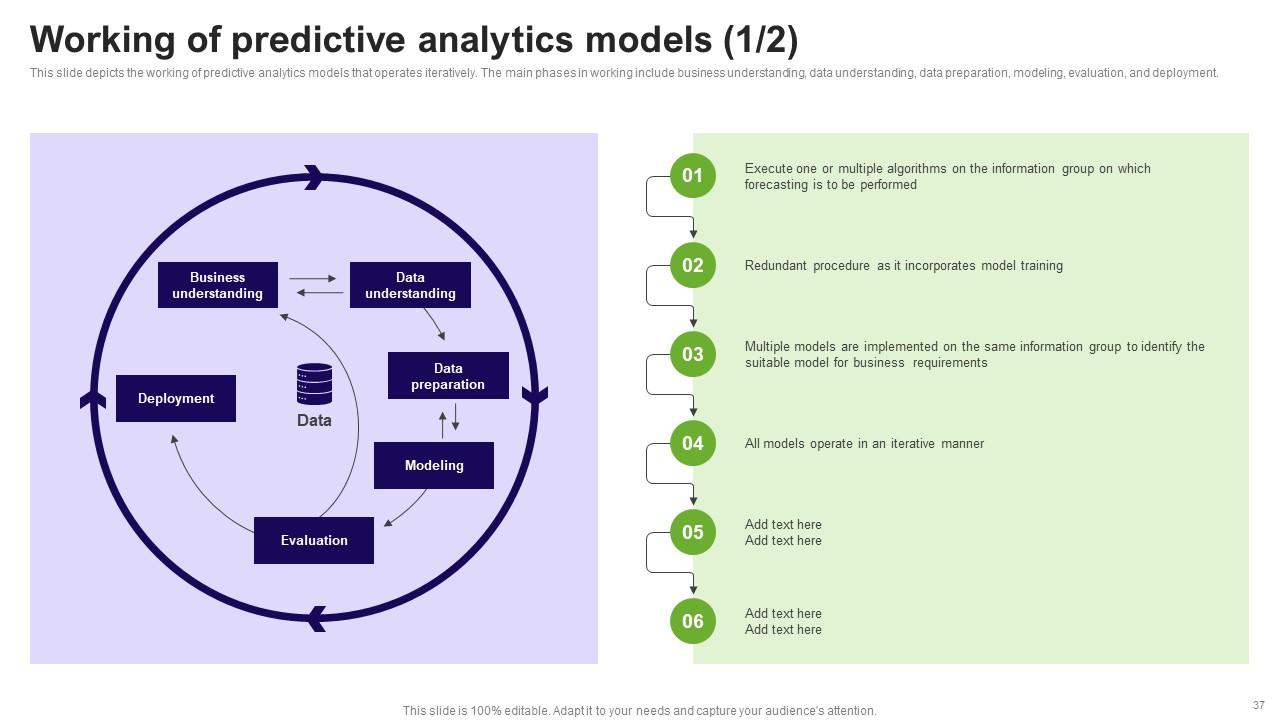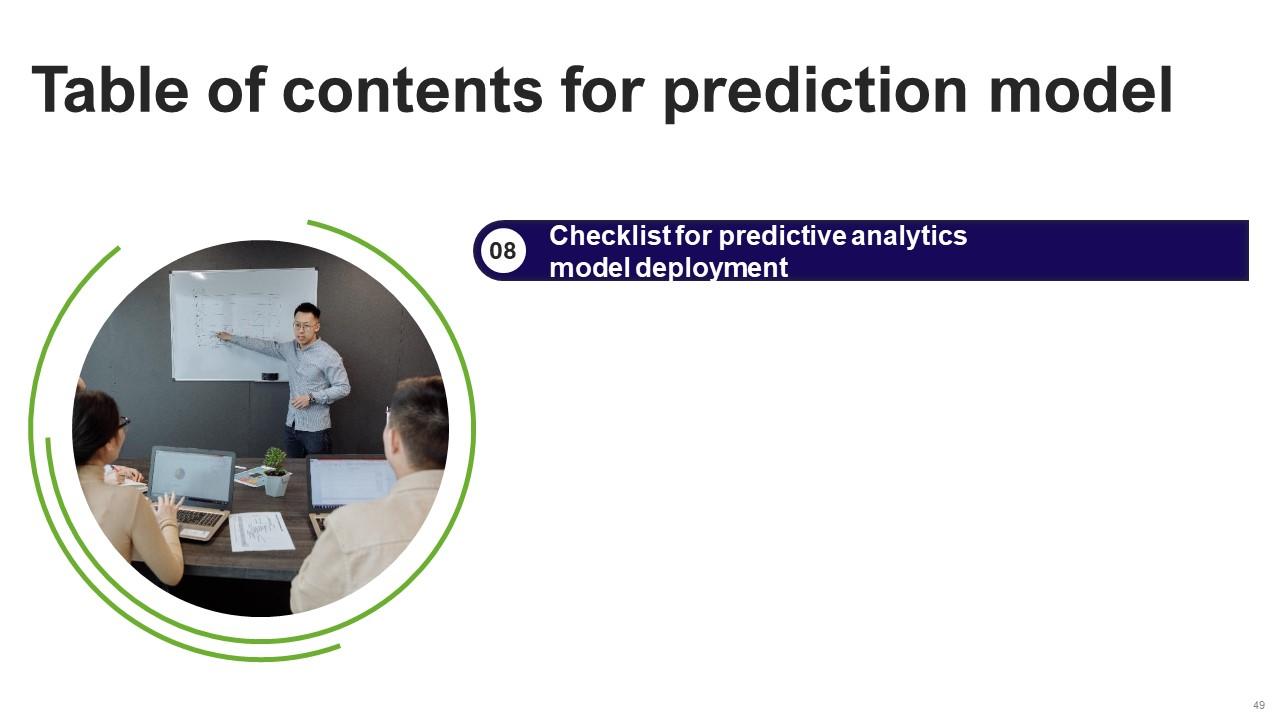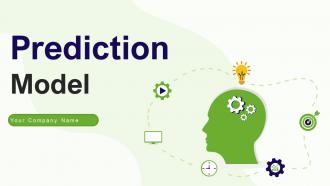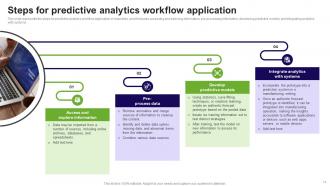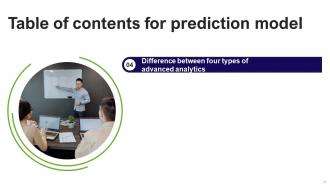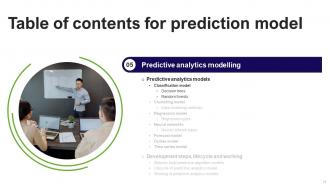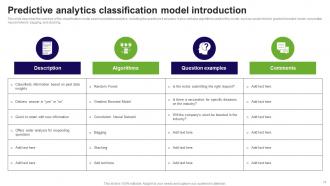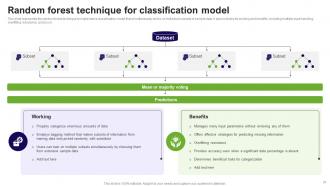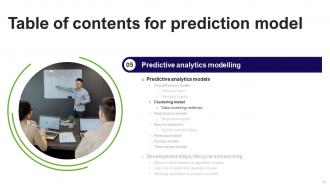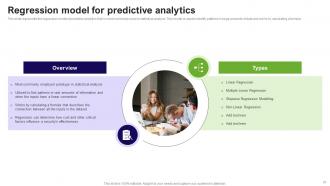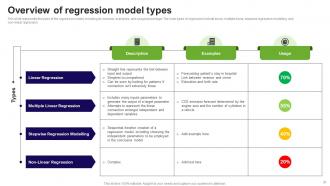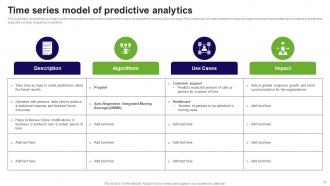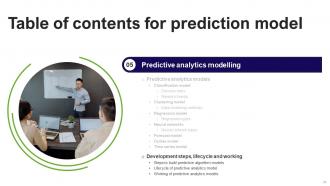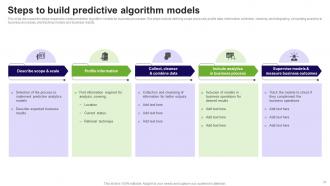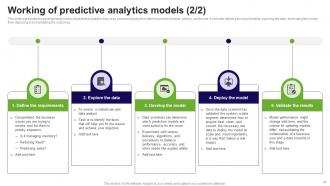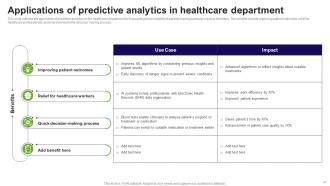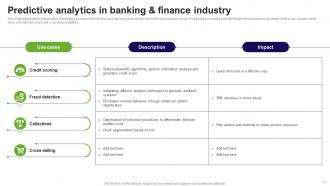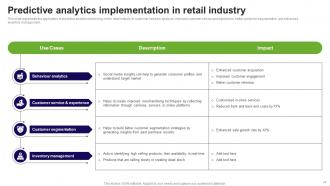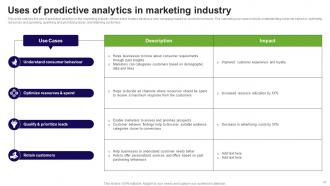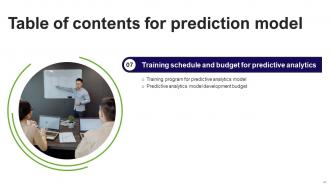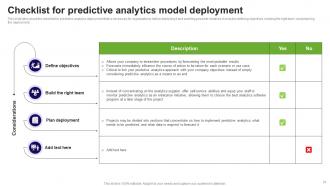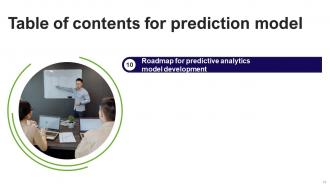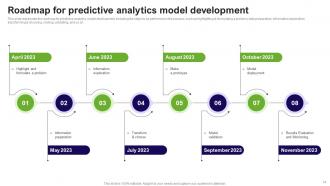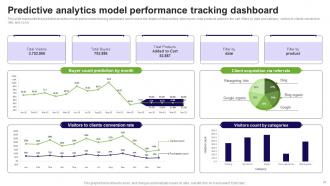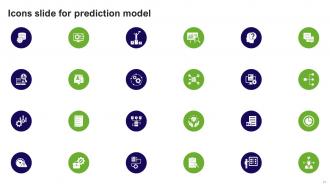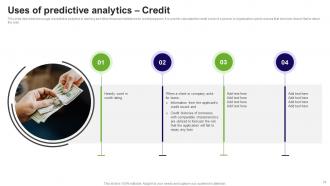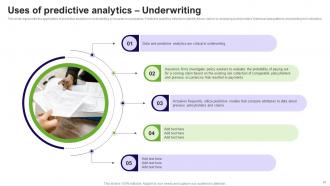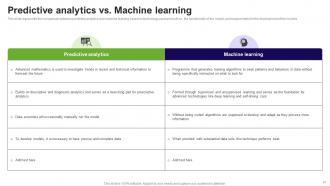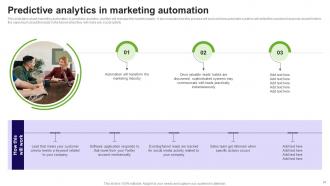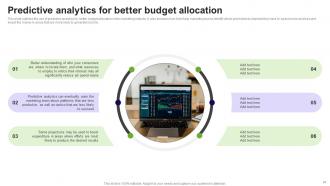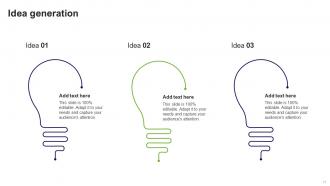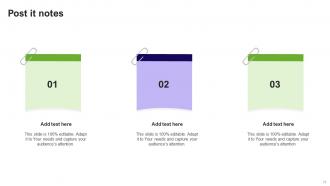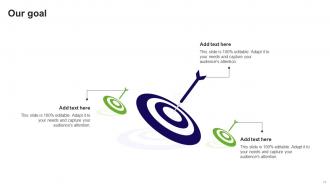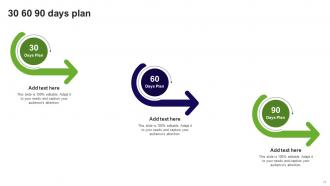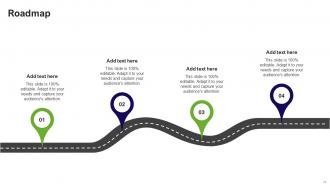Prediction Model Powerpoint Presentation Slides
Predictive analytics has become a valuable tool across various industries, and our Prediction Model template is designed to efficiently guide you through the process. This template provides a comprehensive overview of predictive analytics, which involves using statistical techniques, machine learning algorithms, and other tools to analyze historical data and make predictions about future events or outcomes. The Predictive Analytics deck covers the introduction to predictive analytics, its framework, and different models, highlighting its importance and applications. The Estimation Model PowerPoint presentation showcases various predictive analytics tools and their workflow, while explaining the differences between the four types of advanced analytics. The Forecast Model section explores different predictive analytics models such as classification and clustering models and provides insights into the industries that are already leveraging predictive analytics, including healthcare, banking, finance, and more. Additionally, the Prospective Analysis module includes a training program and budget considerations for developing a predictive analytics model. The template also offers a checklist, timeline, and roadmap for deploying a predictive analytics model, along with a performance tracking dashboard. Do not miss out on this valuable resource. Access it now and harness the power of predictive analytics for your business.
- Google Slides is a new FREE Presentation software from Google.
- All our content is 100% compatible with Google Slides.
- Just download our designs, and upload them to Google Slides and they will work automatically.
- Amaze your audience with SlideTeam and Google Slides.
-
Want Changes to This PPT Slide? Check out our Presentation Design Services
- WideScreen Aspect ratio is becoming a very popular format. When you download this product, the downloaded ZIP will contain this product in both standard and widescreen format.
-

- Some older products that we have may only be in standard format, but they can easily be converted to widescreen.
- To do this, please open the SlideTeam product in Powerpoint, and go to
- Design ( On the top bar) -> Page Setup -> and select "On-screen Show (16:9)” in the drop down for "Slides Sized for".
- The slide or theme will change to widescreen, and all graphics will adjust automatically. You can similarly convert our content to any other desired screen aspect ratio.
Compatible With Google Slides

Get This In WideScreen
You must be logged in to download this presentation.
PowerPoint presentation slides
Enthrall your audience with this Prediction Model Powerpoint Presentation Slides. Increase your presentation threshold by deploying this well-crafted template. It acts as a great communication tool due to its well-researched content. It also contains stylized icons, graphics, visuals etc, which make it an immediate attention-grabber. Comprising seventy seven slides, this complete deck is all you need to get noticed. All the slides and their content can be altered to suit your unique business setting. Not only that, other components and graphics can also be modified to add personal touches to this prefabricated set.
Content of this Powerpoint Presentation
Slide 1: This slide introduces the Prediction Model. Commence by stating Your Company Name.
Slide 2: This slide depicts the Agenda of the presentation.
Slide 3: This slide incorporates the Table of contents.
Slide 4: This slide highlights the Title for the Topics to be discussed next.
Slide 5: This slide represents the predictive analytics introduction that is used for forecasts action, behaviors, and trends using recent and past information.
Slide 6: This slide outlines the overview of the predictive analytics framework and its components.
Slide 7: This slide depicts the overview of predictive analytics models, including the predictive problems they solve.
Slide 8: This slide elucidates the Heading for the Components to be discussed next.
Slide 9: This slide showcases the importance of predictive analytics in different industries.
Slide 10: This slide presents the importance of predictive analytics that covers detecting fraud, improving operations, optimizing marketing campaigns, etc.
Slide 11: This slide displays the Title for the Ideas to be discussed next.
Slide 12: This slide depicts the tools used for predictive analytics to perform operations in predictive models.
Slide 13: This slide represents the predictive analytics workflow that is widely used in managing energy loads in electric grids.
Slide 14: This slide states the steps for predictive analytics workflow application in industries.
Slide 15: This slide reveals the Heading for the Ideas to be covered further.
Slide 16: This slide shows the difference between the main types of advanced analytics, and it includes diagnostic, descriptive, predictive, and prescriptive analytics.
Slide 17: This slide incorporates the Title for the Components to be discussed next.
Slide 18: This slide describes the overview of the classification model used in predictive analytics.
Slide 19: This slide exhibits the Decision trees technique for classification model.
Slide 20: This slide represents the random forest technique to implement a classification model that simultaneously works on individual subsets of sample data.
Slide 21: This slide portrays the Heading for the Topics to be covered in the following template.
Slide 22: This slide talks about the Predictive analytics clustering model overview.
Slide 23: This slide outlines the two primary information clustering methods used in the predictive analytics clustering model.
Slide 24: This slide portrays the Title for the Topics to be covered further.
Slide 25: This slide represents the regression model of predictive analytics that is most commonly used in statistical analysis.
Slide 26: This slide showcases the types of the regression model, including its overview, examples, and usage percentage.
Slide 27: This slide reveals the Heading for the Components to be discussed next.
Slide 28: This slide depicts the neural networks model of predictive analytics that behave in the same manner as a human brain does.
Slide 29: This slide presents the different types of the neural network model, including their overview, use cases and usage.
Slide 30: This slide indicates the Title for the Ideas to be discussed further.
Slide 31: This slide focuses on the Predictive analytics forecast model introduction.
Slide 32: This slide talks about the outliers model used for predictive analytics, including its use cases, impact and algorithm.
Slide 33: This slide elucidates the Time series model of predictive analytics.
Slide 34: This slide states the Heading for the Components to be covered in the forth-coming template.
Slide 35: This slide discusses the steps required to create predictive algorithm models for business processes.
Slide 36: This slide depicts the lifecycle of the predictive analytics model, and it includes highlighting & formulating a problem, data preparation, etc.
Slide 37: This slide shows the working of predictive analytics models that operates iteratively.
Slide 38: This slide represents the development process of predictive analytics that uses recent and past information to predict behavior, actions, and trends.
Slide 39: This slide contains the Title for the Contents to be discussed next.
Slide 40: This slide outlines the application of predictive analytics in the healthcare department for forecasting the probability of patients having particular medical disorders.
Slide 41: This slide presents the application of predictive analytics in the finance and banking sector as they deal with vast amounts of data.
Slide 42: This slide talks about using predictive analytics in manufacturing forecasting for optimal use of resources.
Slide 43: This slide depicts the usage of predictive analytics technology in the government sector to improve cybersecurity as they are the main drivers of computer technology growth.
Slide 44: This slide represents the application of predictive analytics technology in the retail industry.
Slide 45: This slide elucidates the use of predictive analytics in the marketing industry, where active traders develop a new campaign based on customer behavior.
Slide 46: This slide presents the Heading for the Ideas to be covered further.
Slide 47: This slide represents the training program for the predictive analytics model, and it includes the name of teams, trainer names, modules to be covered in training, and the schedule and venue of the training.
Slide 48: This slide describes the budget for developing predictive analytics model by covering details of project cost summary, amount, etc.
Slide 49: This slide displays the Title for the Ideas to be discussed in the following template.
Slide 50: This slide talks about the checklist for predictive analytics deployment that is necessary for organizations before deploying it and avoiding possible mistakes.
Slide 51: This slide mentions the Heading for the Topics to be covered in the forth-coming template.
Slide 52: This slide depicts the roadmap for predictive analytics model development, including describing the project, information collection, etc.
Slide 53: This slide indicates the Heading for the Contents to be covered in the forth-coming template.
Slide 54: This slide presents the roadmap for predictive analytics model development, including the steps to be performed in the process, such as highlighting & formulating a problem, data preparation, etc.
Slide 55: This slide portrays the Title for the Topics to be discussed in the next template.
Slide 56: This slide reveals the Predictive analytics model performance tracking dashboard.
Slide 57: This slide is used for depicting Additional information.
Slide 58: This is the Icons slide containing all the Icons used in the plan.
Slide 59: This slide describes the usage of predictive analytics in banking and other financial institutions for credit purposes.
Slide 60: This slide exhibit the application of predictive analytics in underwriting by insurance companies.
Slide 61: This slide showcases the Application of predictive analytics in fraud detection in various industries.
Slide 62: This slide represents the predictive analytics application in predictive maintenance and monitoring to avoid difficulties later.
Slide 63: This slide discusses Predictive analytics vs. machine learning.
Slide 64: This slide focuses on Predictive analytics in finding better customer leads.
Slide 65: This slide depicts how predictive analytics help identifies prospects faster in the marketing industry.
Slide 66: This slide reveals the Column chart.
Slide 67: This slide is used for the purpose of Comparison.
Slide 68: This is the About Us slide for showcasing the company-related information.
Slide 69: This slide illustrates the Venn Diagram.
Slide 70: This slide exhibits the 30 60 90 days plan for effective planning.
Slide 71: This slide presents the Roadmap of the firm.
Slide 72: This is the Thank you slide for acknowledgement.
Prediction Model Powerpoint Presentation Slides with all 82 slides:
Use our Prediction Model Powerpoint Presentation Slides to effectively help you save your valuable time. They are readymade to fit into any presentation structure.
FAQs
Predictive analytics is a process used to forecast future actions, behaviors, and trends by analyzing past and current data. It uses statistical algorithms and machine learning techniques to make predictions and identify patterns that can guide decision-making.
The key components of the predictive analytics framework include data collection, data preparation, model training, model evaluation, and prediction. These components work together to analyze data, build models, and make accurate predictions.
Predictive analytics is essential in various industries, including healthcare for medical disorder forecasting, finance and banking for data analysis, manufacturing for resource optimization, government for cybersecurity improvement, retail for customer behavior analysis, and marketing for campaign development based on customer behavior.
Predictive analytics can be utilized in fraud detection by analyzing patterns and anomalies in transaction data. By identifying unusual behaviors and patterns associated with fraudulent activities, predictive analytics can help financial institutions prevent fraudulent transactions and protect their customers.
Predictive analytics and machine learning are related fields, but they have distinct differences. Predictive analytics focuses on making predictions based on historical and current data, while machine learning involves developing algorithms that learn from data and improve over time. In other words, predictive analytics is a subset of machine learning.
-
“Immediate response, professional support, and effective solutions that were customized and immediately provided. Well done- Thank you!”
-
The pricing page of this website is very sorted. I felt no pain while buying the PPTs.




